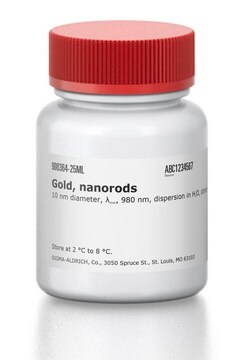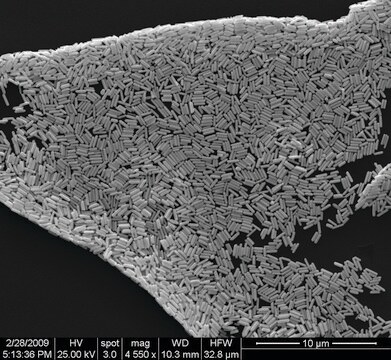900367
Gold, nanorods
25 nm diameter, λmax, 650 nm, dispersion in H2O, citrate capped
Synonym(s):
Au Nanorods
Sign Into View Organizational & Contract Pricing
All Photos(1)
About This Item
UNSPSC Code:
12352200
Recommended Products
Quality Level
form
dispersion
dispersion in H2O
nanorod
concentration
50 μg/mL in H2O
L
69-73 nm
diameter
25 nm
pH
7
λmax
650 nm
storage temp.
2-8°C
Looking for similar products? Visit Product Comparison Guide
Related Categories
General description
- Longitudinal peak = 650 nm ± 20 nm
- Longitudinal absorbance OD = 1
- Transverse peak= 520 nm ± 5 nm
- Transverse absorbance OD = 0.5
- Citrate capped
Application
Owing to the excellent optical properties arising from the surface plasmon resonance, the gold nanorods find applications in biomedical imaging, drug delivery and photothermal treatment. The citrate capped nanorods are non-cytotoxic compared to the CTAB capped nanorods and are well suited for the biomedical applications.
Caution
Do not freeze
Legal Information
This product was produced under the methods claimed in U.S. Pat. Nos. 8,956,440 and 8,241,922
Storage Class Code
12 - Non Combustible Liquids
WGK
nwg
Flash Point(F)
Not applicable
Flash Point(C)
Not applicable
Certificates of Analysis (COA)
Search for Certificates of Analysis (COA) by entering the products Lot/Batch Number. Lot and Batch Numbers can be found on a product’s label following the words ‘Lot’ or ‘Batch’.
Already Own This Product?
Find documentation for the products that you have recently purchased in the Document Library.
Customers Also Viewed
Application of Gold Nanorods for Photothermal Therapy in Ex Vivo Human Oesophagogastric Adenocarcinoma.
Singh M, et al.
Journal of Biomedical Nanotechnology, 12(3), 481-481 (2016)
Prit Manish Lakhani et al.
Nanotechnology, 26(43), 432001-432001 (2015-10-09)
Photothermal therapy, also referred to as optical hyperthermia or photothermal ablation, is an emerging strategy for treating solid tumours. Colloidal gold converts the absorbed light into localized heat via a non-radiative mechanism, surface plasmon resonance, which ablates the solid tumours.
Our team of scientists has experience in all areas of research including Life Science, Material Science, Chemical Synthesis, Chromatography, Analytical and many others.
Contact Technical Service




